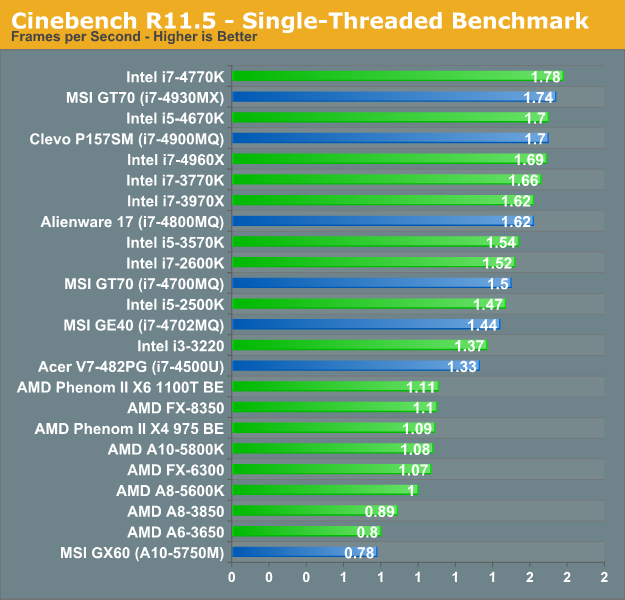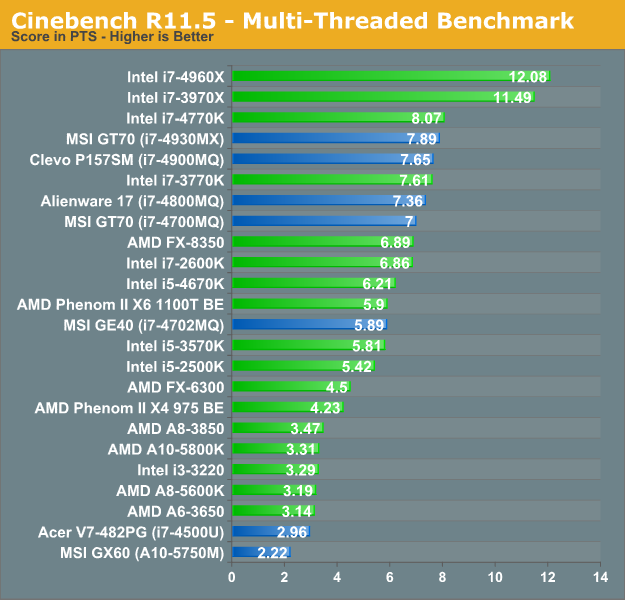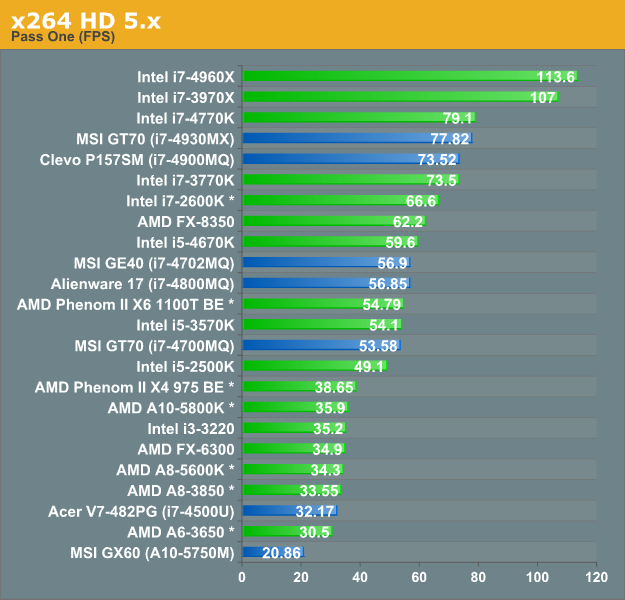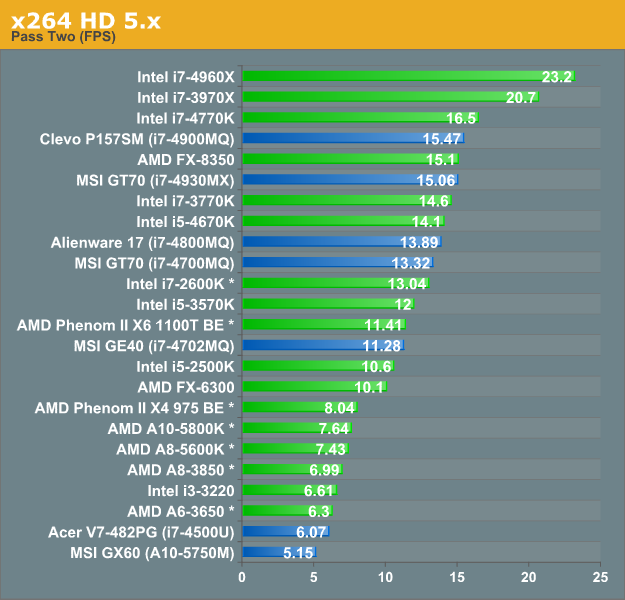Analyzing the Price of Mobility: Desktops vs. Laptops
by Jarred Walton on September 7, 2013 5:55 PM ESTCPU/General Performance Discussion
With that out of the way, let’s focus on the remaining two areas, starting with CPU performance. I’ve grabbed several generations of desktop CPUs from both AMD (K10.5, Llano, Trinity, Bulldozer, and Piledriver – we don’t currently have Richland results, but they’re generally 5-10% higher than Trinity) and Intel (Sandy Bridge, Sandy Bride-E, Ivy Bridge, Ivy Bridge-E, and Haswell) and combined those results with the latest mobile CPUs (Haswell quad-core, Haswell ULT, and Richland). We’ve got two benchmarks that are common to our CPU and laptop we’re going to look at: Cinebench 11.5 (single- and multi-threaded) and x264 HD 5.x video encoding (first and second pass).
Unfortunately, we don’t have results for all of the desktop CPUs in x264 HD 5.x, though you can get an idea of where they should fall by looking at the x264 HD 3.x results. We’ve gone ahead and used the x264 3.x scaling for desktop CPUs where we don’t have 5.x results, and marked those results with an asterisk (*) in the following graphs. The first pass tends to be about 2x as fast with x264 HD 3.x, unless you have four cores with Hyper-Threading in which case scaling is closer to 1.5x (and 6-cores results in scaling of around 1.08x). The scaling in the second pass is much more uniform, with 3.x being around 2.75x as fast as 5.x. Since we’re already comparing apples and oranges in a sense (desktop and laptops, with different motherboard, RAM, etc.) we’re really just interested in an estimate of performance. Do not take the following charts as 100% definitive, but rather as a baseline comparison.




It used to be that if you wanted top CPU performance, a desktop system was absolutely required. These days, for lightly-threaded workloads the gap has narrowed substantially: a moderate i7-4700MQ Intel Haswell processor will get you around 85% of the performance of the desktop i7-4770K, and the i7-4930MX will get you 98% of the single-threaded performance. Even the i7-4500U Ultrabook is able to deliver 75% of the 4770K performance. Move to heavily threaded workloads and the gap grows (particularly if we included the hex-core processors), but the 4700MQ and 4930MX are still 81-87%/91-98% of the 4770K performance – it’s the dual-core mobile CPUs that really take a hit, with the i7-4500U delivering roughly one third (37-41%) the performance of the 4770K. Of course, if you’re not doing CPU intensive tasks like video encoding, the single-threaded performance will be the more pertinent result.
The AMD side of the equation isn’t nearly so rosy, at least if you want performance anywhere near that of a top-end desktop. Llano, Trinity, and Richland have been far more focused on reducing power use and increasing integrated graphics performance than on boosting CPU performance. The result is that in single-threaded performance, the fastest mobile Richland APU is less than half the performance of the 4770K, and in the multi-threaded tests it’s 26-31% of the 4770K performance. Comparing mobile Richland to desktop AMD parts doesn’t really help much either: in the single-threaded Cinebench result, it basically matches the Llano A6-3650 and is 12% slower than the A8-3850, while it trails most of the other AMD CPUs/APUs by nearly 30%. Move to multi-threaded workloads and it’s only able to deliver 30-60% of the more powerful AMD desktop APUs (and 60-80% of the desktop Llano APUs). Richland is still “fast enough”, but it’s definitely a value proposition as opposed to a performance option – the iGPU of Richland may be faster than HD 4000/4400/4600, but dGPUs like the GT 730M are still roughly twice as fast and available for not much more money. But we’re skipping ahead….
Summarizing the general performance of our mobile platforms, we’re able to come pretty close to the performance of desktop systems, and while there’s still a price premium in effect it’s definitely getting smaller than in the past. The least expensive laptop/notebook I can find right now with a quad-core Haswell CPU is the HP Envy 15t-j000, which you can currently get for $700 after the $100 instant discount. That will get you 8GB RAM, 1TB HDD, and Windows 8, but not too much else. Adding a 1080p LCD ($50), GT 740M ($70), and a backlit keyboard ($30) brings the total to $850. That’s roughly the same performance as a Sandy Bridge i7-2600K, and slightly faster than the Haswell i5-4670K. You can get a pre-built desktop from Newegg for $700 (which adds in an HD 7750 GPU), while a DIY system with similar specs to the laptop (e.g. no dGPU) will set you back $672 (see table below) – not including a mouse, keyboard, display, or speakers.
| Mainstream Desktop PC | ||
| Component | Description | Price |
| CPU | Intel Core i5-4670 (Quad-core, 3.4-3.8GHz, 6MB L3, 22nm, 84W) | $200 |
| Motherboard | ASRock Z87 Pro3 LGA-1150 | $115 |
| Memory | 2x4GB DDR3-1600 CL9 1.5V RAM | $65 |
| Storage | Seagate 1TB 7200RPM HDD | $70 |
| Optical Drive | SATA DVDRW (Lite-On) | $18 |
| Case | Antec Three Hundred | $60 |
| Power Supply | Seasonic 350W 80 Plus Bronze | $44 |
| Operating System | Windows 8 64-bit (OEM) | $100 |
| Total | $672 | |
In other words, if all you want is a computer for moderate needs, it’s not hard to see why laptops are displacing desktops for many people. In this case we’re able to get the same level of performance for potentially less money (depending on whether or not you need to buy an LCD, keyboard, and mouse). Desktops are still going to be far more upgradeable, and you can take a “basic use” desktop like the one above and upgrade it with a high-end graphics card for $300 to get a potent gaming PC. Adding more memory, more storage, upgrading the motherboard and CPU, etc. are all things that you can do with a desktop, whereas with laptops typically only the RAM and storage can be upgraded/replaced and if anything else breaks you’ll have to send it in for repairs (or buy a new laptop).p
We can go down to lower price points of course – there are desktop PCs with moderate hardware starting at just over $300, and they’re still more upgradable than laptops, but similar performance laptops can be had for about the same price, especially if you look at some of the previous generation hardware. It’s mostly a question of how much performance you want/need, and whether you’re interested in the potential to upgrade components down the road. If you don’t have any plans of adding more RAM, storage, or a GPU the case for laptops is stronger now than ever. And let’s not forget that most laptops have an idle power draw south of 20W, compared to 40-60W for a typical desktop (and that’s not including the display or speakers on the desktop), so the energy factor also favors laptops.










110 Comments
View All Comments
nerd1 - Monday, September 9, 2013 - link
My main machine is a 17" alienware with 680M, which is comparable to GTX660, and it cost me less than $2K with 16GB ram and 500GB SSD / 1TB HDD. It is not terribly heavy (I carry it with backpack every day), fast enough for my work, and runs most game at 1080p easily.Similarly powerful desktop will be around $1400 (after adding display, keyboard and SSD), and I will still need a quality laptop with SSD, which won't come below $1000. So I think powerful laptop systems totally make sense for *some* people who are fine with 1080p gaming.
Notmyusualid - Monday, September 9, 2013 - link
Jarred, amazing if you can get that performance for ~$1k.But most of us outside the USA pay through the nose for our electronics.
My machine cost, (sourced in the UK) 3k GBP, without fancy SSDs, TB disk, nor memory. Factor in 800 GBP for those and your 3800 GBP machine is $5966.38 - including case but *without taxes*. And VAT (sales tax) here is 17.5%.
Oh how I wish I could have spent that on a Desktop... but as noted, that is not an option for me.
Love the article, and the site - keep up the good work, and try not to cry reading those prices! :)
JarredWalton - Tuesday, September 10, 2013 - link
Obviously prices have come down since your original purchase on some parts, but yeah -- desktop GTX 760 with a bit of overclocking is going to be pretty close to 780M SLI performance. Some cases it might be a bit slower, but you could always upgrade to a slightly faster GPU for not much more money. Glad I don't have to pay your prices!JlHADJOE - Tuesday, September 17, 2013 - link
Well I never thought about bringing a desktop along. I figured for most people the setup would be a desktop at home, and a laptop on the road. I suppose you're the exception here.My desktop is a 4770k and GTX780. I'm not sure if it's faster than your M18x, but I imagine they'd be about even. I have a Macbook Air for when I'm mobile.
LDW - Sunday, September 8, 2013 - link
Thank you for an interesting analysis. I would like to suggest another angle for a future analysis....Constrain the laptops and desktops to use just the on-chip graphics processing made available from Intel and AMD, and pick several games that place lighter loads on the hardware to use to study their performance. These games may be older or may be current games with constrained settings.
The question to be asked by the analysis is "How is the on-chip graphics doing in in the market? How does it compete with the discrete graphics (mobile and static)? Might there come a time in the future where the graphics performance of the on-chip graphics processors be 'good enough'?"
I think the answer to the last is yes, but haven't a clue when that will occur. Thanks again for an interesting analysis.
LDW
jtd871 - Sunday, September 8, 2013 - link
I was a bit disappointed to see that mobile IVB was not included as a comparison point, as many mobile owners will have purchased in the past several years.As has been inidicated by many others, the performance just has to be good enough. My lappie is a iBuyPower CZ-17 (17" 108p, IVB i7, GTX675m) with aftermarket RAM and SSD upgrades. I probably have $1800 in it. The cost is worth the smaller footprint. My kids are using my previous laptop (Lenovo ThinkPad T61 w/Core2Duo & NVS discrete gfx), which cost the same amount 5 years previously.
As a comparison, the performance gained for the same money over 5 years is tremendous. My 'best value' paper build list for a $1500 desktop (including OS) would probably smoke my current laptop, but the laptop is still very nice for 1080p gaming and 1) I didn't have to put it (all) together myself 2) it is portable.
The whole notion of battery life on a gaming laptop is kind of silly. It's basically a glorified UPS (which I appreciate), as I have pretty much never heard of anyone gaming without being on the mains.
JarredWalton - Sunday, September 8, 2013 - link
Ivy Bridge wasn't included because, outside of the iGPU and battery life, it's not really all that different from Haswell. In fact, outside of the iGPU and battery life, even Sandy Bridge offers competitive performance to Ivy Bridge.As for battery life on a gaming notebook being silly, I don't think most people really expect to be able to play a modern AAA title like Battlefield, Call of Duty, etc. and get good battery life, but when you're not gaming there's really no need for battery life to suck.
By my calculations, a 17.3" gaming notebook at idle should be able to draw around 10-13W max, mostly depending on the LCD brightness. Sadly, most are still drawing 20-25W at idle. There's no reason for this other than the manufacturers being too lazy to properly optimize the firmware for power savings.
Termie - Sunday, September 8, 2013 - link
Great article, Jarred! Wow, it's amazing to see what those Haswell mobile quad-cores can do!By the way, you refer to the i7-4500U in the text, but your chart has the i7-4200U. I think the text is correct, and the chart isn't.
nunomoreira10 - Sunday, September 8, 2013 - link
Either cpu perfomance has evolved so much on laptops or evolved so litle on desktops.intel need some competition and fast
the bright side is i wont be losing much if i get a mainstream quadcore laptop
JarredWalton - Sunday, September 8, 2013 - link
The thing is, for the most part people don't need faster CPUs. If we had CPUs that were 10X as fast, what would we do that we're not already doing? Intel has plenty of competition: ARM is the big one, but Intel is almost competing with their own past success. Until there's software that needs more CPU performance, focusing on other priorities like power and graphics makes more sense.And for the record, I don't think we need lots of new "innovations" in software that require faster CPUs. Look at Android and iOS; those require basically one fourth the performance of Windows to be plenty fast (outside of some web page rendering), and they deliver tons better battery life. More than anything, I think we're fast approaching the point where monolithic OSes, CPUs, etc. start to become irrelevant.
A few more years and I could do most of what I need to do with an iPad/Android tablet with a good keyboard attachment. I'll still prefer laptops though, because larger displays and keyboards are more comfortable for me to use -- at least, I will until we reach the point where we can actually start connecting our brains directly into our computers. Hahaha....